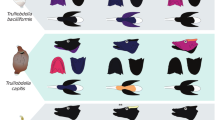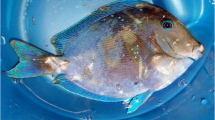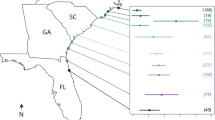Abstract
Successful invasions are largely explained by some combination of enemy release, where the invader escapes its natural enemies from its native range, and low biotic resistance, where native species in the introduced range fail to control the invader. We examined the extent to which parasites may mediate both release and resistance in the introduction of Pacific red lionfish (Pterois volitans) to Atlantic coral reefs. We found that fewer lionfish were parasitized at two regions in their introduced Atlantic range (The Bahamas and the Cayman Islands) than at two regions in their native Pacific range (the Northern Marianas Islands and the Philippines). This pattern was largely driven by relatively high infection rates of lionfish by didymozoan fluke worms and parasitic copepods (which may be host-specific to Pterois lionfishes) in the Marianas and the Philippines, respectively. When compared with sympatric, native fishes in the Atlantic, invasive lionfish were at least 18 times less likely to host a parasite in The Bahamas and at least 40 times less likely to host a parasite in the Cayman Islands. We found no indication that lionfish introduced Pacific parasites into the Atlantic. In conjunction with demographic signs of enemy release such as increased density, fish size, and growth of invasive lionfish, it is possible that escape from parasites may have contributed to the success of lionfish. This is especially true if future studies reveal that such a loss of parasites has led to more energy available for lionfish growth, reproduction, and/or immunity.


Similar content being viewed by others
References
Adlard R, Lester R (1994) Dynamics of the interaction between the parasitic isopod, Anilocra pomacentri, and the coral reef fish, Chromis nitida. Parasitology 109:311–324
Albins MA (2013) Effects of invasive Pacific red lionfish Pterois volitans versus a native predator on Bahamian coral-reef fish communities. Biol Invasions 15:29–43. doi:10.1007/s10530-012-0266-1
Albins MA (2015) Invasive Pacific lionfish Pterois volitans reduce abundance and species richness of native Bahamian coral-reef fishes. Mar Ecol Prog Ser 522:231–243. doi:10.3354/meps11159
Albins MA, Hixon MA (2008) Invasive Indo-Pacific lionfish Pterois volitans reduce recruitment of Atlantic coral-reef fishes. Mar Ecol Prog Ser 367:233–238. doi:10.3354/meps07620
Bates D, Mächler M, Bolker BM, Walker SC (2015) Fitting linear mixed-effects models using lme4. J Stat Softw 67:1–48. doi:10.18637/jss.v067.i01
Bax N, Carlton JT, Mathews-Amos A et al (2001) The control of biological invasions in the World’s oceans. Conserv Biol 15:1234–1246
Bax N, Williamson A, Aguero M et al (2003) Marine invasive alien species: a threat to global biodiversity. Mar Policy 27:313–323. doi:10.1016/S0308-597X(03)00041-1
Bernadsky G, Goulet D (1991) A natural predator of the lionfish, Pterois miles. Copeia 1:230–231
Binning SA, Roche DG, Layton C (2012) Ectoparasites increase swimming costs in a coral reef fish. Biol Lett 9:20120927–20120927. doi:10.1098/rsbl.2012.0927
Black AN, Weimann SR, Imhoff VE et al (2014) A differential prey response to invasive lionfish, Pterois volitans: prey naiveté and risk-sensitive courtship. J Exp Mar Biol Ecol 460:1–7. doi:10.1016/j.jembe.2014.06.002
Blakeslee AMH, Fowler AE, Keogh CL (2013) Marine invasions and parasite escape: updates and new perspectives. In: Lesser MP (ed) Advances in marine biology, 1st edn. Academic Press, Cambridge, pp 87–169
Bullard SA, Barse AM, Curran SS, Morris JA (2011) First record of a digenean from invasive Lionfish, Pterois cf. volitans, (Scorpaeniformes: Scorpaenidae) in the Northwestern Atlantic Ocean. J Parasitol 97:833–837. doi:10.1645/GE-2746.1
Byers JE (2000) Competition between two estuarine snails: implications for invasions of exotic species. Ecology 81:1225–1239. doi:10.1890/0012-9658(2000)081[1225:CBTESI]2.0.CO;2
Carlton JT (1996) Pattern, process, and prediction in marine invasion ecology. Biol Conserv 78:97–106. doi:10.1016/0006-3207(96)00020-1
Colautti RI, Ricciardi A, Grigorovich IA, MacIsaac HJ (2004) Is invasion success explained by the enemy release hypothesis? Ecol Lett 7:721–733. doi:10.1111/j.1461-0248.2004.00616.x
Colorni A, Diamant A (2005) Hyperparasitism of trichodinid ciliates on monogenean gill flukes of two marine fish. Dis Aquat Organ 65:177–180
Cox JG, Lima SL (2006) Naiveté and an aquatic-terrestrial dichotomy in the effects of introduced predators. Trends Ecol Evol 21:674–680. doi:10.1016/j.tree.2006.07.011
Cribb TH, Bray RA, Wright T, Pichelin S (2002) The trematodes of groupers (Serranidae: Epinephelinae): knowledge, nature and evolution. Parasitology 124:S23–S42. doi:10.1017/S0031182002001671
Cure K, Benkwitt CE, Kindinger TL et al (2012) Comparative behavior of red lionfish Pterois volitans on native Pacific versus invaded Atlantic coral reefs. Mar Ecol Prog Ser 467:181–192. doi:10.3354/meps09942
Darling ES, Green SJ, O’Leary JK, Côté IM (2011) Indo-Pacific lionfish are larger and more abundant on invaded reefs: a comparison of Kenyan and Bahamian lionfish populations. Biol Invasions. doi:10.1007/s10530-011-0020-0
Dojiri M, Cressey RF (1987) Revision of the taeniacanthidae (copepoda: poecilostomatoida) parasitic on fishes and sea urchins. Smithsonian Institution Press, Washington
Finley RJ, Forrester GE (2003) Impact of ectoparasites on the demography of a small reef fish. Mar Ecol Prog Ser 248:305–309. doi:10.3354/meps248305
Forrester GE, Finley RJ (2006) Parasitism and a shortage of refuges jointly mediate the strength of density dependence in a reef fish. Ecology 87:1110–1115
Green SJ, Côté IM (2009) Record densities of Indo-Pacific lionfish on Bahamian coral reefs. Coral Reefs 28:107–107. doi:10.1007/s00338-008-0446-8
Green SJ, Akins JL, Maljković A, Côté IM (2012) Invasive lionfish drive Atlantic coral reef fish declines. PLoS ONE 7:e32596. doi:10.1371/journal.pone.0032596
Grutter AS, Crean AJ, Curtis LM et al (2011) Indirect effects of an ectoparasite reduce successful establishment of a damselfish at settlement. Funct Ecol 25:586–594. doi:10.1111/j.1365-2435.2010.01798.x
Hanley KA, Vollmer DM, Case TJ (1995) The distribution and prevalence of helminths, coccidia and blood parasites in two competing species of gecko: implications for apparent competition. Oecologia 102:220–229. doi:10.1007/BF00333254
Hatcher MJ, Dunn AM (2011) Parasites in Ecological Communities, 1st edn. Cambridge University Press, New York
Hothorn T, Bretz F, Westfall P (2008) Simultaneous inference in general parametric models. Biom J 50:346–363. doi:10.1002/bimj.200810425
Jackman S (2015) pscl: Classes and methods for R developed in the Political Science Computational Laboratory, Stanford University. Department of Political Science, Stanford University. Stanford, California. R package version 1.4.9. URL http://pscl.stanford.edu/
Keane RM, Crawley MJ (2002) Exotic plant invasions and the enemy release hypothesis. Trends Ecol Evol 17:164–170
Kindinger TL (2014) Behavioral response of native Atlantic territorial three spot damselfish (Stegastes planifrons) toward invasive Pacific red lionfish (Pterois volitans). Environ Biol Fishes. doi:10.1007/s10641-014-0279-y
Kulbicki M, Beets JP, Chabanet P et al (2012) Distributions of Indo-Pacific lionfishes Pterois spp. in their native ranges: implications for the Atlantic invasion. Mar Ecol Prog Ser 446:189–205. doi:10.3354/meps09442
Kvach Y, Skóra KE (2007) Metazoa parasites of the invasive round goby Apollonia melanostoma (Neogobius melanostomus) (Pallas) (Gobiidae: Osteichthyes) in the Gulf of Gdańsk, Baltic Sea, Poland: a comparison with the Black Sea. Parasitol Res 100:767–774. doi:10.1007/s00436-006-0311-z
Levine JM, Adler PB, Yelenik SG (2004) A meta-analysis of biotic resistance to exotic plant invasions. Ecol Lett 7:975–989. doi:10.1111/j.1461-0248.2004.00657.x
Loerch SM, McCammon AM, Sikkel PC (2015) Low susceptibility of invasive Indo-Pacific lionfish Pterois volitans to ectoparasitic Neobenedenia in the eastern Caribbean. Environ Biol Fishes. doi:10.1007/s10641-015-0415-3
Lönnstedt OM, McCormick MI (2013) Ultimate predators: lionfish have evolved to circumvent prey risk assessment abilities. PLoS ONE 8:e75781. doi:10.1371/journal.pone.0075781
MacNeil C, Dick JTA, Hatcher MJ et al (2003) Parasite-mediated predation between native and invasive amphipods. Proc R Soc B Biol Sci 270:1309–1314. doi:10.1098/rspb.2003.2358
Maljković A, Leeuwen TE, Cove SN (2008) Predation on the invasive red lionfish, Pterois volitans (Pisces: Scorpaenidae), by native groupers in the Bahamas. Coral Reefs 27:501. doi:10.1007/s00338-008-0372-9
Marsh-Hunkin KE, Gochfeld DJ, Slattery M (2013) Antipredator responses to invasive lionfish, Pterois volitans: interspecific differences in cue utilization by two coral reef gobies. Mar Biol 160:1029–1040. doi:10.1007/s00227-012-2156-6
Mitchell CE, Power AG (2003) Release of invasive plants from fungal and viral pathogens. Nature 421:625–627. doi:10.1038/nature01317
Molnar JL, Gamboa RL, Revenga C, Spalding MD (2008) Assessing the global threat of invasive species to marine biodiversity. Front Ecol Environ 6:485–492. doi:10.1890/070064
Morris JA, Whitfield PE (2009) Biology, ecology, control and management of the invasive Indo-Pacific lionfish: an updated integrated assessment. Washington, D.C
O’Farrell S, Bearhop S, McGill RAR et al (2014) Habitat and body size effects on the isotopic niche space of invasive lionfish and endangered Nassau grouper. Ecosphere 5:1–11
Paperna I (1972) Monogenea of red sea fishes, III. Dactylogyridae from littoral and reef fishes. J Helminthol 46:47–62
Paterson RA, Townsend CR, Poulin R, Tompkins DM (2011) Introduced brown trout alter native acanthocephalan infections in native fish. J Anim Ecol 80:990–998. doi:10.1111/j.1365-2656.2011.01834.x
Poulin R, Morand S (2000) The diversity of parasites. Q Rev Biol 75:277–293. doi:10.1086/393500
Pronin NM, Fleischer GW, Baldanova DR, Pronina SV (1997) Parasites of the recently established round goby (Neogobius melanostomus) and tubenose goby (Proterorhinus marmoratus) (Cottidae) from the St. Clair River and Lake St. Clair, Michigan, USA. Folia Parasitol (Praha) 44:1–6
Pusack TJ, Benkwitt CE, Cure K, Kindinger TL (2016) Invasive Red Lionfish (Pterois volitans) grow faster in the Atlantic Ocean than in their native Pacific range. Environ Biol Fishes 99:571–579
R Core Team (2016) R: A language and environment for statistical computing. R Foundation for Statistical Computing, Vienna, Austria. https://www.R-project.org/
Ramos-Ascherl Z, Williams EH, Bunkley-Williams L et al (2015) Parasitism in Pterois volitans (Scorpaenidae) from coastal waters of Puerto Rico, the Cayman Islands, and the Bahamas. J Parasitol 101:50–56. doi:10.1645/13-422.1
Randall JE (1967) Food habits of reef fishes of the West Indies. Stud Trop Oceanogr 5:665–847
Rilov G, Crooks JA (2008) Biological invasions in marine ecosystems: ecological, management, and geographic perspectives. Springer, Heidelberg
Ruiz-Carus R, Matheson RE, Roberts DE, Whitfield PE (2006) The western Pacific red lionfish, Pterois volitans (Scorpaenidae), in Florida: evidence for reproduction and parasitism in the first exotic marine fish established in state waters. Biol Conserv 128:384–390. doi:10.1016/j.biocon.2005.10.012
Schofield PJ (2009) Geographic extent and chronology of the invasion of non-native lionfish (Pterois volitans [Linnaeus 1758] and P. miles [Bennett 1828]) in the Western North Atlantic and Caribbean Sea. Aquat Invasions 4:473–479. doi:10.3391/ai.2009.4.3
Schofield PJ (2010) Update on geographic spread of invasive lionfishes (Pterois volitans [Linnaeus, 1758] and P. miles [Bennett, 1828]) in the Western North Atlantic Ocean, Caribbean Sea and Gulf of Mexico. Aquat Invasions 5:S117–S122. doi:10.3391/ai.2010.5.S1.024
Sellers AJ, Ruiz GM, Leung B, Torchin ME (2015) Regional variation in parasite species richness and abundance in the introduced range of the invasive lionfish Pterois volitans. PLoS One 10:e0131075. doi:10.1371/journal.pone.0131075
Semmens BX, Buhle ER, Salomon AK, Pattengill-Semmens CV (2004) A hotspot of non-native marine fishes: evidence for the aquarium trade as an invasion pathway. Mar Ecol Prog Ser 266:239–244. doi:10.3354/meps266239
Shea K, Chesson P (2002) Community ecology theory as a framework for biological invasions. Trends Ecol Evol 17:170–176. doi:10.1016/S0169-5347(02)02495-3
Shen C (1957) Parasitic Copepods from Fishes of China, part I: cyclopoida (1). Acta Zool Sin 9(4):297–327
Sikkel PC, Cheney KL, Côté IM (2004) In situ evidence for ectoparasites as a proximate cause of cleaning interactions in reef fish. Anim Behav 68:241–247. doi:10.1016/j.anbehav.2003.10.023
Sikkel PC, Schaumburg CS, Mathenia JK (2006) Diel infestation dynamics of gnathiid isopod larvae parasitic on Caribbean reef fish. Coral Reefs 25:683–689. doi:10.1007/s00338-006-0154-1
Sikkel PC, Tuttle LJ, Cure K et al (2014) Low susceptibility of invasive red lionfish (Pterois volitans) to a generalist ectoparasite in both its introduced and native ranges. PLoS ONE 9:e95854. doi:10.1371/journal.pone.0095854
Stachowicz JJ, Whitlatch RB, Osman RW (1999) Species diversity and invasion resistance in a marine ecosystem. Science 286:1577–1579
Strauss A, White A, Boots M (2012) Invading with biological weapons: the importance of disease-mediated invasions. Funct Ecol 26:1249–1261. doi:10.1111/1365-2435.12011
Sutherland WJ, Clout M, Côté IM et al (2010) A horizon scan of global conservation issues for 2010. Trends Ecol Evol 25:1–7. doi:10.1016/j.tree.2009.10.003
Thieltges DW, Reise K, Prinz K, Jensen KT (2008) Invaders interfere with native parasite–host interactions. Biol Invasions 11:1421–1429. doi:10.1007/s10530-008-9350-y
Torchin ME, Lafferty KD, Kuris AM (2001) Release from parasites as natural enemies: increased performance of a globally introduced marine crab. Biol Invasions 3:333–345. doi:10.1023/A:1015855019360
Torchin ME, Lafferty KD, Kuris AM (2002) Parasites and marine invasions. Parasitology 124(7):137–151
Torchin ME, Lafferty KD, Dobson AP et al (2003) Introduced species and their missing parasites. Nature 421:628–630. doi:10.1038/nature01346.1
Torchin ME, Byers JE, Huspeni TC (2005) Differential parasitism of native and introduced snails: replacement of a parasite fauna. Biol Invasions 7:885–894. doi:10.1007/s10530-004-2967-6
Uma Devi DV, Shyamasunari K (1980) Studies on the copepod parasites of fishes of the Waltair Coast: family Taeniacanthidae. Crustaceana 39:197–208. doi:10.1017/CBO9781107415324.004
Vignon M, Sasal P (2009) Fish introduction and parasites in marine ecosystems: a need for information. Environ Biol Fishes 87:1–8. doi:10.1007/s10641-009-9553-9
Vignon M, Sasal P, Galzin R (2009a) Host introduction and parasites: a case study on the parasite community of the peacock grouper Cephalopholis argus (Serranidae) in the Hawaiian Islands. Parasitol Res 104:775–782. doi:10.1007/s00436-008-1254-3
Vignon M, Sasal P, Rigby MC, Galzin R (2009b) Multiple parasite introduction and host management plan: case study of lutjanid fish in the Hawaiian archipelago. Dis Aquat Organ 85:133–145. doi:10.3354/dao02071
Zeileis A, Kleiber C, Jackman S (2008) Regression Models for Count Data in R. J Stat Softw 27:1–25. doi:10.18637/jss.v027.i08
Acknowledgements
For work in The Bahamas, we thank the staff of the Perry Institute of Marine Science for logistic support, and Mark Albins, Tye Kindinger, Emily Pickering, Gabe Scheer, and Kristal Ambrose for assisting with data collection. For work in the Cayman Islands, we thank the staff of the Central Caribbean Marine Institute for their logistic support, and Tye Kindinger and Casey Benkwitt for their extensive help in the field. For work in the Philippines, we thank Hilconida Calumpong and the staff of the Silliman University Marine Laboratory for supporting our visit, as well as Dioscoro Inocencio, Tina Santos, and Malatapay Bantay Dagat for assistance with fieldwork and obtaining fish, and Rene Abesamis, Renclar Jadloc, and Jennifer McIlwain for assistance with permit processing. For hosting and assisting us in Guam, we thank the lab of Jennifer McIllwain at the University of Guam, as well as Jason Miller. Omar Amin, Al Dove, Julianne Passarelli, and Zullaylee Ramos-Ascherl helped identify many parasites. Casey Benkwitt, Alex Davis, Stephanie Green, Kurt Ingeman, and Tye Kindinger helped to improve early versions of this manuscript.
Funding
This study was funded by research grants to MA Hixon by the U.S. National Science Foundation (NSF OCE 08-51162 and 12-33027). LJ Tuttle received the NSF Graduate Research Fellowship, and scholarships from the American Academy of Underwater Sciences, the American Museum of Natural History, and Oregon State University.
Author information
Authors and Affiliations
Corresponding author
Ethics declarations
Conflict of interest
The authors declare that they have no conflict of interests.
Electronic supplementary material
Below is the link to the electronic supplementary material.
Rights and permissions
About this article
Cite this article
Tuttle, L.J., Sikkel, P.C., Cure, K. et al. Parasite-mediated enemy release and low biotic resistance may facilitate invasion of Atlantic coral reefs by Pacific red lionfish (Pterois volitans). Biol Invasions 19, 563–575 (2017). https://doi.org/10.1007/s10530-016-1342-8
Received:
Accepted:
Published:
Issue Date:
DOI: https://doi.org/10.1007/s10530-016-1342-8




